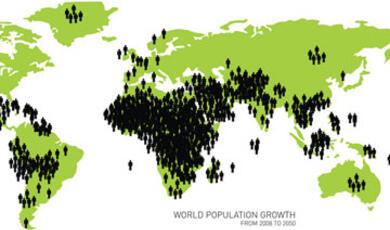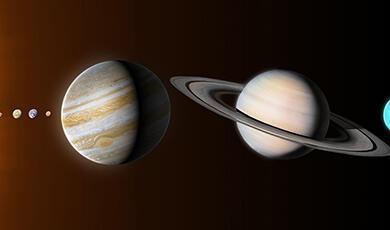Beauty in the Heavens
Share
- Details
- Transcript
- Audio
- Downloads
- Extra Reading
Three of the most beautiful sights that we can observe in the sky are the Aurora Borealis and eclipses of the Sun and Moon. This lecture explains how such phenomena arise, describes what we can see and gives details of upcoming eclipses.
Download Transcript
BEAUTY IN THE HEAVENS
Professor Ian Morison
An appreciation of some of the beautiful astronomical phenomena that we can observe in our skies.
Rainbows
Rainbows can be observed whenever there are water drops in the air lit by sunlight shining from behind the observer. They can also be seen near waterfalls or fountains and created artificially by dispersing water droplets from a hosepipe into the air during a sunny day.
The rainbow's appearance is caused by the dispersion of sunlight as it passes through the water within a raindrop. To form the Primary Rainbow, the light enters the raindrop at the top and is first refracted as it enters the surface of the raindrop, splitting the light into a continuous spectrum of colour. This beam is reflected off the back of the drop, is focussed to a point within the drop and then spreads out again before being refracted again as it leaves the drop. The amount by which light is refracted depends upon its wavelength, and hence its colour. The shorter wavelengths of blue light are refracted at a greater angle than red light, but due to the crossing of the spectrum within the drop, the blue light leaves the drop at a higher angle than the red. As we observe myriads of raindrop all reflecting and refracting the light, we will see the red light coming from higher raindrops than those that appear blue, so red forms the outer colour of the rainbow.
If the conditions are right it is possible to observe a Secondary Rainbow. In this case, the sunlight has entered the drop near the bottom and has twice been reflected within it and twice focussed so that the order of colours is reversed and red light leaves the drop at a higher angle than the blue. As we observe myriads of raindrop all reflecting and refracting the light, we will see the blue light coming from higher raindrops than those that appear red from our direction. So blue forms the outer colour of the rainbow and the colours in the secondary rainbow are reversed.
Iridescent Clouds
This is an image taken at Lake Bled, Slovenia in early July of what are known as Iridescent Clouds. They are caused by the diffraction of light in very small uniform droplets rather than the refraction of light that, for example, results in rainbows. They are sometimes called Mother of Pearl clouds. The diffraction causes different colours to be reinforced in differing directions so we see changing colours across a band of cloud. They are only normally seen very close to the sun - in this image the Sun was just 15 degrees to the right - which is perhaps why we rarely notice them as we cannot look close to the Sun without being blinded by its light. In this case, the Sun was just hidden by an overhanging balcony.
The Aurora
A beautiful manifestation of the interaction of the solar wind with our atmosphere are the coloured light displays sometimes observed in the night sky. They are most often seen within a band centred arund the north and south magnetic poles and are known as the Aurora Borealis and Aurora Australis respectively. (Aurora is the Roman goddess of the dawn, Boreas is the Greek name for the north wind, and Australis is the Latin word for south.) The Aurora Borealis is often called the northern lights as it tends to be seen as a green or reddish glow in the northern sky. It is most commonly seen around the vernal and autumnal equinoxes, though it is not known why this should be so.
Auroras are caused by the collision of charged particles with atoms high in the Earth's upper atmosphere. As the Earth's field lines open out into space above the north and south magnetic poles, charged particles may more easily reach the upper atmosphere in the regions near the magnetic poles. There, they collide with the atoms of gases in the atmosphere, and lift electrons into higher energy levels. The electrons then cascade down to their ground states so emitting light. Most appears to be emitted by emissions from atomic oxygen, resulting in a greenish glow at a wavelength of 557.7 nm and a dark-red glow at 630.0 nm. Amongst the many other colours that are sometimes observed, excited atomic nitrogen gives a blue colour whilst molecular nitrogen produces a purple hue. Often the auroral glow is in the form of "curtains" that tend to be aligned in an east-west direction. Sometimes these curtains change slowly but at other times they seem to be in continuous motion. Their shape is determined by the direction of the Earth's field in the region of the observer and observations have shown that electrons from the solar wind spiral down magnetic field lines towards the Earth. The author can testify to the awesome sight that results when field lines guide electrons down to a bright auroral patch directly above the observer. Due to perspective, the converging auroral rays appear as vertical rays of light reaching upwards to what is called a "corona" directly above.
The Moon Illusion
The Moon is the fifth largest satellite in the Solar System. It has a diameter slightly more than a quarter that of the Earth and its average distance is about 30 times that of the Earth.
The well known 'Moon' illusion makes the Moon appear largest when near the Horizon. However, it will of course be closer to us when highest in the sky and its angular size will actually be about 1.5% larger! Our perception of size is linked with how far away we believe an object is away from us. It appears that we 'see' the celestial sphere above us, not as a true hemisphere, but one which is flattened overhead so that we 'believe' that the objects above us in the sky are 'nearer' to us than those near the horizon. So, observing the Moon above us, we 'believe' it to be closer and mentally reduce its perceived size.
Lunar Eclipses
If the plane of the Moon's orbit was the same as that of the Earth's orbit around the Sun, we would get eclipses of the Sun at new Moon and that of the Moon at full Moon. However, due to the fact that the Moon's orbit is inclined by about 5 degrees, the Moon is often above or below the Sun-Earth line, and eclipses happen less often.
It might be thought that the Moon would totally disappear, but light that is scattered through the Earth's atmosphere falls on the Moon so we can still see it. If we observed the Earth from the Moon during a lunar eclipse we would see that it would have a red limb as the dust in the Earth's atmosphere scatters blue light more than blue. (This also explains why the Sun appears red at sunset.) The Moon thus takes on a reddish hue at totality with the brightness and colour very dependant on the amount of dust in the Earth's atmosphere. Following a major volcanic eruption, so little light reaches the Moon it can appear a very dull dark grey but conversely, when the atmosphere is relatively free of dust, its can appear a beautiful orange red.
Image of the 2007 Lunar Eclipse: Ian Morison
We have a chance of observing a total eclipse of the moon on the morning of February 21st. However, as the moon's path is well towards the edge of the Earth's umbra, I expect that the lower part of the Moon will be quite bright.
Solar Eclipses
Due to the tidal interactions between the Earth and the Moon, the Moon is gradually moving further away from the Earth. The fact that it now has an angular size which is usually just greater than that of our Sun gives rise to what is probably the most spectacular of celestial events - a total solar eclipse.
To give a total eclipse, the Moon must lie in the plane of the solar system (the plane containing the Earth and Sun), be at new moon and have an angular size greater than that of the Sun. The Moon's orbit is inclined at 5 degrees to the plane of the solar system, so it will usually be above or below the ecliptic plane at the time of new-moon so we do not get eclipses every month. The Moon's orbital period around the Earth is 27.3 days so it will cross the plane of the ecliptic (at what are called the nodal points) once every 13.65 days. The Moon is new or full every 29.5 days, so the two events will coincide at the lowest common multiple of 13.65 and 29.5. In fact, as the Moon doesn't have to be precisely at the nodal points of its orbit for an eclipse to be total, there is some tolerance and solar eclipses will recur approximately every 177 days. (6 x 29.5 = 177 and 13 x 13.65 = 177.45). As the Earth's shadow is relatively large compared to the moon, total eclipses of the Moon occur somewhat more often.
But an eclipse is not necessarily total. Both the Earth and the Moon have elliptical orbits. In fact, the Moon's angular size varies by about ~12%; from 0.5548 degrees at perigee, when it is closest to the Earth, down to 0.4923 degrees at apogee, when it is furthest from the Earth. If the Moon is furthest from the Earth ( so minimising the Moon's angular size) and the Earth is closest to the Sun (at perihelion, so making the Sun's angular size bigger) then the Moon cannot cover the Sun completely and we get what is called an Annular Eclipse when a ring of the Sun is still visible around the edge of the Moon. This is often called a 'ring of fire' and is particularly spectacular when seen close to dawn or dusk when the Sun's light is reddened.
During a total eclipse the Moon's shadow will first touch the Earth's surface at the start of what is termed the "eclipse track". The width and length of the track will depend on positions of the Moon and Earth in their orbits. Close to the Earth's equator, the Moon is nearer than at the poles so its angular size is greater and the eclipse track is wider, so it is here that the longest period of totality can be observed. The longest possible total eclipse is approximately 7 minutes 30 seconds long. This would be observed at the equator when the Earth is at aphelion (farthest from the Sun) and the Moon is at perigee (closest to the Earth). The longest eclipse that may be observed in the next 3,000 years is on July 16th 2186 and will have a duration of 7 minutes 29 seconds. The longest in recent times was observed by many from Hawaii on July 11th 1991 when totality lasted 6 minutes and 53 seconds. It is not a coincidence that the dates within the year are so close. The Earth is at aphelion on July 4th so the longest periods of totality will occur close to that date.
The ancients observed that sets of eclipses, both solar and lunar, recurred every 18 years 11 days and 8 hours - a time period called the Saros. Because of the 1/3 day in this period each set of eclipses is observed 1/3 of the way around the globe at successive saros periods. Solar eclipses with thus be seen in the same region of the Earth after 3 saros periods; 54 years and 34 days.
The sequence of Events during a Total Solar Eclipse
1) First Contact:
This is when the limb of the Moon first begins to cover the Sun's disk. The watchers breathe a sight of relief that the predictions are correct and that an eclipse will really happen! One can then begin to observe the, increasingly covered, Sun with eclipse glasses, with small telescopes equipped with suitable solar filters, or by projecting the Sun's image onto white card with a telescope or monocular. "Pinhole cameras" made by the leaves of a tree will form multiple images of the partially eclipsed Sun on the ground below.
As totality gets very close, the angular size of the remaining disk becomes very small and acts like a point light source. This light is passing through the turbulent atmosphere which had small compressions and rarefactions. These act like convex and concave lenses. Below a "convex lens" which tends to focus the light the intensity on the ground is greater whilst under a concave lens it is less. As the upper atmosphere winds are moving these "lenses" across the line of sight of the Sun, the changes in brightness that we observe on the ground move quickly. The moving patterns of light and dark that we can see on the ground are called Shadow Bands and are not easy to see. A white sheet laid on the ground can be a useful aid to observing them.
As the Moon's limb is not smooth we will see the final rays of the Sun through the valley's between the lunar mountains. This gives a beautiful effect called 'Baily's Beads'. Also at this time we can begin to see the pinky-red colour of the Sun's Chromosphere.
2) Second Contact:
Finally the moments that the watchers have eagerly awaited comes. The Sun's disk becomes totally obscured. The last rays of the Sun pass through the lunar mountains at one point giving what is perhaps one the most beautiful views during an eclipse: the Diamond Ring.
Baily's Beads Diamond Ring
The chromosphere - or colour sphere - is a thin layer of the Sun's atmosphere, about 10,000 kilometers deep just above the photosphere (which is the region of the Sun's atmosphere that we see in visible light). The chromosphere has a reddish colour as much of its light comes from the H-alpha spectral line of hydrogen which is dark red in colour. It can only be seen directly in the short period just before it is covered by the Moon's limb.
Within the chromosphere we may see spicules or fibrils which are thin bands of luminous plasma which rise and fall through the chromosphere in time scales of about 10 minutes. We may be lucky to see giant plumes of luminous plasma, called solar prominences which rise up through the chromosphere and reach heights of up to 150,000 km.
As our eyes become adjusted to the dark we begin to see the Sun's corona. This is the outer atmosphere of the Sun extending millions of kilometres into space. It is exceedingly hot - between 1 and 3 million K - but its density is 12 orders of magnitude less than the photosphere so it produces only about one-millionth as visible light as the photosphere. It is beautiful 'pearly-white' colour. The extent of the corona is related to the Sunspot cycle: at times of solar minimum the corona is most prominent above the Sun's equatorial regions extending outwards in what are called streamers. Above the poles the Sun's magnetic field is often beautifully delineated. Around solar maximum the corona tends to be brighter and is more evenly distributed though tending to be most prominent above sunpot regions.
Coronium
The spectrum of the corona - the coronal spectrum - contains emission lines. When the emission lines observed in the solar corona during a solar eclipse were correlated with emission lines from known elements on Earth, a green emission line was found that had no match. It was thought to relate to an unknown element and, as it had it had first been observed in the Solar Corona, it was provisionally named Coronium. However, in the 1930's, Walter Grotrian and Bengt Edlén, discovered that this spectral line was due to highly-ionized iron - its high level of ionization being due to the extreme temperatures within the solar corona.
3rd Contact:
This is when the period of totality ends - we have another chance to see the diamond ring and Baily's beads before the Moon's motion gradually allows more and more of the Sun's disk to be seen.
4th Contact:
The eclipse is over and many of those viewing will start looking forwards to the next one!
The 2008 Total Solar Eclipse
The eclipse begins in the early morning in Northern Canada and then passes over Greenland, Russia and Siberia before crossing into Mongolia and China where it concludes at Sunset. In the United Kingdom we will be able to see a small partial eclipse, either by using specialist 'eclipse' glasses or projecting an image onto a white screen. As you would expect from the eclipse track which passes well to the north of the UK, the greatest obscuration will be in Scotland where, in Edinburgh, 35% of the Suns' disk will be covered - enough to cause a small but detectable dimming. There, the Moon's limb will start to cover the Sun's disk at about 08:23 UT (09:23 BST) with the maximum partial eclipse at about 09:19 UT (10:19 BST) with the partial eclipse ending at 10:10 UT. Further south the period of the eclipse will be less lasting from 08:33 UT (09:33 BST) until 10:04 UT (11:04 BST) in London where the maximum coverage of the solar disk will be reduced to about 21%. The Sun will, however, have an elevation of ~40 degrees and there is a good chance of clear skies.
A number of companies are providing expeditions to see the eclipse and their web addresses are given at the end of the transcript should you wish to make an attempt to observe the total eclipse. There are cruises going to the north of Russia, trips on the Trans-Siberian railway to Novosibirsk to view the eclipse from Siberia or by plane to northern China where the Sun will be lower in the sky but the chance of cloud cover is rather less.
A superb website to look at is the NASA eclipse page:
http://sunearth.gsfc.nasa.gov/eclipse/SEmono/TSE2008/TSE2008.html
This give detailed plots of the eclipse path and, perhaps more important, a map showing the mean cloudyness along it.
The maximum period of totality will be 2 minutes and 27 seconds in northern Russia. It drops to 2 minutes and 18 seconds near Novosibirsk with the Sun at an altitude of 30 degrees. In northern China the Sun's elevation will be down to ~18 degrees and the period of totality will have dropped to 1 minute and 57 seconds.
However the length of totality is not the most important consideration - that lies with the likelyhood of clear skies. The average cloud cover along the eclipse path does not drop below 50% until Novosibirsk in Siberia and reaches a minimum at about 30% close to the town of Hami close to Outer Mongoloia before it rises again to 50% near Xian in China. It should, however, be born in mind that, where the cloud cover is least, the eclipse is seen later in the day - this means that there is somewhat more chance that the Sun will lie behind what cloud there is and one should also note that clouds tend to build up during the day.
Your professor hopes to be leading a trip to Hami and this is also where Fred Espinak, who is the world expert on eclipses, will be going.
There is no 'star' location for this eclipse as there was for that in 2006 when the Libyan desert was the obvious choice both to have the maximum chance to see the eclipse (virtually 100%) as well as the longest time of totality. (It has to be said the there were some hardships involved, and your professor is a little ashamed to say that his group stayed in 5 star luxury on the Turkish coast and, perhaps a little luckily, had a perfect view too!)
I think that it is fair to say that nowhere would one have a really high chance of seeing the eclipse so that one should choose an expedition that would be worthwhile in itself so that, even if the sky is cloudy on eclipse day, you will have had an enjoyable time. It could perhaps be pointed out that the darkness during totality when it is cloudy is quite an experience in itself - as was attested to by the thousands who attempted to observe the 1999 eclipse in Cornwall!
The 2009 Solar Eclipse
The total eclipse on July 22nd 2009 is the longest until 2132, so is perhaps worth giving serious consideration! The eclipse path traverses half of Earth: the Moon's umbral shadow first falls on India and crosses through Nepal, Bangladesh, Bhutan, Myanmar and China. The path of totality then crosses Japan's Ryukyu Islands and curves southeast through the Pacific Ocean where the maximum duration of totality reaches 6 min 39 s.
Unfortunately, nowhere along the eclipse path is the chance of clear skies greater than 50%. Across China the likelihood of cloud cover varies between 50 and 60% before rising somewhat and then falling at the end of the track to just below 50 %. One possible clue to the best location is to see where Fred Espernak, known as Mr Eclipse and who produces the NASA eclipse pages referred to above, is going to - in this case it is southern China.
The website page for the 2009 eclipse is: http://sunearth.gsfc.nasa.gov/eclipse/SEmono/TSE2009/TSE2009.html
Or just put 'Solar eclipse 2009' into Google.
Companies running trips to observe Solar Eclipses:
Ancient World Tours: http://www.ancient.co.uk/ Explorer's Tours: http://www.explorers.co.uk/astro/default.asp Responsible Travel:http://www.responsibletravel.com/Trip/Trip101504.htm On-the-Go Tours: http://www.onthegotours.com/Russia-with-On-the-Go-Tours IAH holidays: http://www.iah-holidays.co.uk/ Explore: heep://www.explore.co.uk
Or just put the names of the company into Google.
© Professor Ian Morison, 2008
This event was on Thu, 07 Feb 2008
Support Gresham
Gresham College has offered an outstanding education to the public free of charge for over 400 years. Today, Gresham plays an important role in fostering a love of learning and a greater understanding of ourselves and the world around us. Your donation will help to widen our reach and to broaden our audience, allowing more people to benefit from a high-quality education from some of the brightest minds.


 Login
Login











